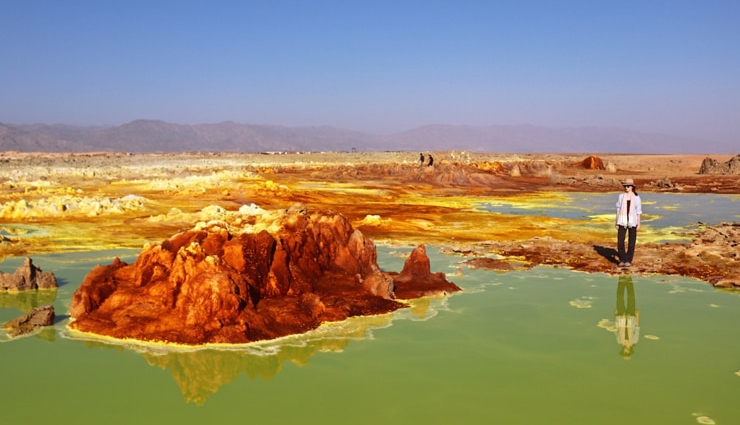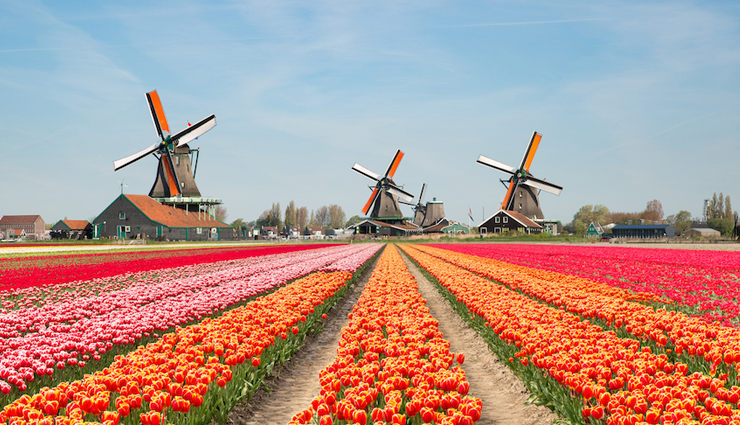

If you love tulips then the tulips fields in the Netherlands will be like a godsent. From far, these fields may seem like colorful strips but as you get closer the fully bloomed tulips covering the strips of land displaying various whimsical colors will truly blow your mind. The cool long spring season that lasts from mid-march to the end of May, makes it the perfect condition for Tulips to thrive in the Netherlands. Not just that the soil is continuously drained to make it more aerated which adds to the perfect tulip growing conditions in this part of the world.
Unlike its name, the tunnel of love is an industrial section of railway which is located near the town of Klevan in Ukraine. The standout feature of this railway line which also makes it one of the most pictured places on Social Media is the lush green arches. Running at the length of 3 to 5 km this place is also one of the favorites among locals and tourists to take soulful walks. The entire line of this railway line is blessed and bounded by thick forest cover and the green tunnel that stretches from 3 to just a little over 4 km making it look like a secret track to a fairytale world.
Spread out over an astounding area of over 10,000 sq. km. Salar De Uyuni is the world’s largest salt flat. Located close to the crest of the Andes on an elevation of over 12,000 feet above sea level, the Salar was formed as a result of transformations between numerous prehistoric lakes. The extraordinary flatness of the Salar’s crust serves as a rich source of salt as well as covers a pool of brine that shows extraordinary Lithium content. The Salar is also a major transportation route across the Bolivian Altiplano along with being a prime breeding ground for flamingoes.
Spread out over 350 hectares, Hitachi Seaside Park is a spacious park located close to Mito in the Ibaraki prefecture and features a huge variety of flowers and other blossoms that will definitely take your breath away. The park also features scenic cycling and walking trail along with a fun amusement park which will give you a whole new perspective to viewing the park. Mimicking the color of the sky, the park’s iconic flower, the blue Nemophila, completely covers the Miharashi Hills from late April to mid-may. The Criss-crossing paths give spectacular views of the Pacific Ocean and the park. By the fall months, the hills get covered entirely in green Kokia bushes that turn red as the weather changes to cooler conditions.
The slope point marks the southernmost point of the south island of New Zealand. The eroded cliffs of this point, which does not have any habitation around and the land is used as a grazing ground for sheep, dip down into the sea making the whole place look extremely dramatic. But what is surreal about this place is the formation of trees here. The cold winds that constantly tear their way through the trees here give them the shape of being permanently slanted towards the direction of the wind. The winds are so harsh and whipping that the trees here are left looking mangled and very gothic in a way.
Located in the Hunan province of China, and very close to Suoxi Valley in south-central China, Tianzi Mountain is one of the most unreal-looking places on earth. The mountain is named after the early Ming dynasty of China and is also a part of the Wulingyuan scenic area which was also included under the UNESCO world heritage site in 1992. These mountains that look like massive stone pillars are quartz sandstone that is believed to have been formed naturally about 400 years ago. The mountains look surreal since they are thin, irregular, and rise high above the ground.
The emerald ice is a natural phenomenon that occurs for a limited time during the winter months and it is another one of the most photographed natural wonders in the world. This natural wonder occurs in Lake Baikal which is situated in eastern Siberia, Russia. Not only is the lake known for being one of the oldest lakes in the world as it dates back to over 20 million years ago but it is also one of the largest and deepest lakes in the world. During the peak winter months, for about 5 months, when the lake freezes over, the ice crust on the lake cracks which look like emerald stone jutting out of the lake.
Giant’s Causeway is a UNESCO world heritage site and a natural reserve that is unlike any other natural rock formation in the world. Spread out over an area of 40,000 interlocking basalt columns, these unnaturally natural formations are a result of the ancient volcanic fissure eruption. In the UK the causeway is also ranked as the 4th greatest natural wonder in the UK. The tops of these formations form stepping stones that lead visitors from the top of the cliff down to the sea. Most of the steps are hexagonal in shape although some other rocks have even 8 sharp sides and edges that make them look like they have been constructed by humans.
Situated in Mudhdhoo Island which is also known as Vaadhoo Island, this unique island is known for its glowing waves that wash over its shores. This natural phenomenon happens due to the presence of millions of bioluminescent microorganisms known as phytoplankton that give the waves fluorescent lighting that looks too surreal to believe. As the sky gets darker these self-illuminating microbes emit a bright light which gives these waves an ethereal effect. June to October is the best time to catch these glowing waves in full glory when the sea temperature remains comparatively warmer as compared to any other month and the possibility of witnessing these glowing waves multiplies tenfold.